“You reap what you sow” is an apt adage for customer satisfaction surveys. The feedback you collect is only as good and valuable as the questions you ask.
Imagine investing hours in crafting the perfect survey, anticipating it will unveil profound insights to steer your business strategy.
However, when the results start pouring in, you realize that the survey falls flat. Instead of assessing customers’ preferences and needs, it leaves you with unhelpful and unsatisfactory feedback.
So, why does this happen?
It all boils down to the questions you pose. By asking the right questions, you can gather actionable insights to help you optimize your product offerings, truly understand your customers, and deliver exceptional customer experiences.
In this blog, we’ll be your guide in designing your customer satisfaction surveys to collect actionable insights.
We’ve meticulously curated a list of the 30 best customer satisfaction survey questions. Not only that, but we’ll also provide valuable tips on how to create and select the perfect questions for your CSAT surveys.
Are you ready to unlock the secrets to customer satisfaction? Let’s dive in.
What are customer satisfaction surveys?
Customer satisfaction surveys are surveys that provide invaluable insights into customers’ satisfaction levels with your products and services. These surveys enable companies to measure and understand how their products, services, and overall customer experience are perceived. Businesses can gather detailed feedback that directly informs various strategic goals by creating targeted surveys. These goals can range from evaluating customer preferences and identifying behavioral trends to creating user journeys and analyzing the effectiveness of specific solutions. CSAT surveys are often delivered directly to customers through various convenient mediums, including in-app pop-ups, chatbots, email campaigns, and other relevant channels, to ensure a high response rate and gather authentic feedback.
What are the Types of Customer Satisfaction Survey Questions?
As the name suggests, customer satisfaction survey questions gauge respondents’ happiness and satisfaction with your products and services.
You can measure transactional and long-term satisfaction levels to get a complete overview of customers’ journeys. Let’s take a quick look at some of the standard customer satisfaction metrics:
Customer Satisfaction Score (CSAT)
“A satisfied customer is one who will continue to buy from you, seldom shop around, refer other customers and, in general, be a superstar advocate for your business.”
The CSAT measures short-term or transactional customer experience. Here, the customers can rate their satisfaction either through a binary response (yes/no or happy/sad face) or a Likert scale that ranges from ‘Very Dissatisfied ‘to ‘Very Satisfied.’
Related read: How to Measure Customer Satisfaction in 8 Quick Steps
Net Promoter Score (NPS)
(NPS) is a standardized customer satisfaction metric for long-term loyalty. It measures customers’ likelihood of recommending the product/service to their friends and colleagues on a scale of 0-10. The respondents are then classified into Promoters(9-10), Passives(7-8), and Detractors(0-6).
Related read: A Complete Guide to Net Promoter Score Program(NPS)
Customer Effort Score (CES)
Customer Effort Score (CES) measures customers’ satisfaction with support services. It’s a short-term metric used to gauge customer experience after the specific service interaction. Respondents are asked to rate how easy or hard it was for them to resolve their issues with customer service.
Related Read- Customer Satisfaction Metrics to Monitor
50+ Best Customer Satisfaction Survey Questions & Examples
There are tons of customer satisfaction survey questions out there. So which ones work best to gauge your customer’s satisfaction level?
Here is a list of 30 questions we recommend. To make it easier for you to find relevant questions, we’ve categorized them by common use cases:
Customer Service Experience Questions
- How would you like to rate the support you received?
- Was the support representative able to resolve the issue?
- How happy are you with the support?
- Was your problem resolved in a satisfactory way?
- Please rate the quality of support provided.
- Are you happy with the time taken to resolve the issue?
- How easy was it to get your query resolved?
- How easy did we make it to get your problem resolved?
- How would you like us to improve our support?
- Please rate the overall support experience.
- Did you experience any difficulties navigating the app/website?
- Was the app/website layout intuitive and user-friendly?
- Were the instructions and labels clear and easy to understand?
- On a scale of 1-5, how would you rate the overall ease of use?
- Did you encounter any technical issues or glitches?
- Are there any features you would like to see added or improved?
- Were you kept informed throughout the support process?
- Did you feel comfortable communicating with the representative?
- What did you appreciate most about your customer service experience on our app/website?
- What could we have done differently to improve your experience?

Customer Loyalty Questions
- How likely are you to recommend our product/service to your friends and colleagues?
- Would you use our product/service again?
- To what extent did our product satisfy your needs?
- Would you switch to a cheaper alternative if available?
- To what extent did our product meet your expectations?
- How would you rate the quality of our products and services?
- To what extent is our product better than the available alternatives?
- How would you feel if you had to stop using our product?
- Is there anything we can do to improve our product or service?
- What features would you like to see in the future?
- How would you rate the value for money of our products/services?
- How often do you engage with our brand on social media or other channels?
- Have you ever shared positive feedback about our brand with others?
- How well do our brand values align with your own personal values?
- How strongly do you feel connected to our brand?
- How frequently do you purchase our products/services?
- Will you try our new products/services?
- Do you plan to spend more with us in the future?

Website/User Experience Questions
- What would you rate the quality of our products/services?
- Was our website easy to navigate?
- How easy was it to find the information you needed on our website?
- Was the website visually pleasing to you?
- Please rate your satisfaction with the selection of products available on the website.
- Was the website quick to load?
- To what extent are you satisfied with the content of the website?
- Would you consider visiting our website again?
- What more can we do to improve our website?
- Is there anything you would like to see on the website?
- Was the content on the website relevant and informative?
- Did the website provide enough detail about our products/services?
- Was the language used on the website clear and easy to understand?
- Are there any features that you think are missing from the website?
- Were you able to easily locate the primary sections of our website?
- On a scale of 1-5, how intuitive was the website to use?
- Did you take any desired actions on the website?
- If not, what prevented you from taking action?
Read More: What Survey Questions Should I Ask?
How to Calculate CSAT
The CSAT, or Customer Satisfaction Score, gauges overall customer satisfaction by calculating the percentage of positive responses. To determine this score, divide the number of satisfied customers (typically those selecting “satisfied” or “very satisfied”) by the total number of respondents and multiply the result by 100. A higher CSAT percentage signifies greater customer contentment.
The formula is: CSAT = (Number of Satisfied Customers / Total Number of Respondents) * 100
FREE. All Features. FOREVER!
Try our Forever FREE account with all premium features!
How to build good customer satisfaction surveys
Here are some ways how you can build amazing customer satisfaction surveys:
Inclusivity and Clarity in Answer Options:
Ensure your answer options cater to a broad spectrum of perspectives and avoid forcing respondents into limited choices that may not accurately reflect their experiences. Define each answer option clearly to prevent ambiguity and ensure accurate interpretation of responses.
Clear, Focused Questions:
Frame questions that are direct and easily understandable, avoiding jargon or overly complex phrasing. Maintain focus on one specific aspect per question to minimize confusion and elicit clear responses.
Flexibility to Skip Irrelevant Questions:
Provide respondents with the option to bypass questions that are not applicable to them. This fosters a positive survey experience and ensures the data collected is pertinent and meaningful.
Conciseness and Goal Orientation:
Keep your surveys brief to encourage participation and completion rates. Each question should contribute directly to the overarching goals of your survey.
Objectivity and Simple Language:
Employ neutral language to prevent any unintentional bias or influence on responses. Maintain clarity and simplicity in questions and answer choices.
Avoid Hypothetical Scenarios:
Focus on actual experiences rather than hypothetical situations to collect reliable and actionable data.
Customer Satisfaction Survey Templates
Customer satisfaction is the cornerstone of any successful business. That’s why Qualaroo offers you the flexibility to create surveys that perfectly align with your brand and objectives.
With this user-friendly platform, you have two options when it comes to creating customer satisfaction surveys. You can start from scratch, using your own set of questions, or you can take advantage of our ready-to-use templates.
The templates are highly customizable and support branding, font choices, color schemes, and the ability to add or remove questions. This ensures that your surveys reflect your unique brand identity, while capturing the specific insights you need to improve customer satisfaction.
You can also leverage conditional logic and ask follow-up questions based on the respondent’s previous answers, enabling you to gather in-depth insights and identify opportunities for growth.
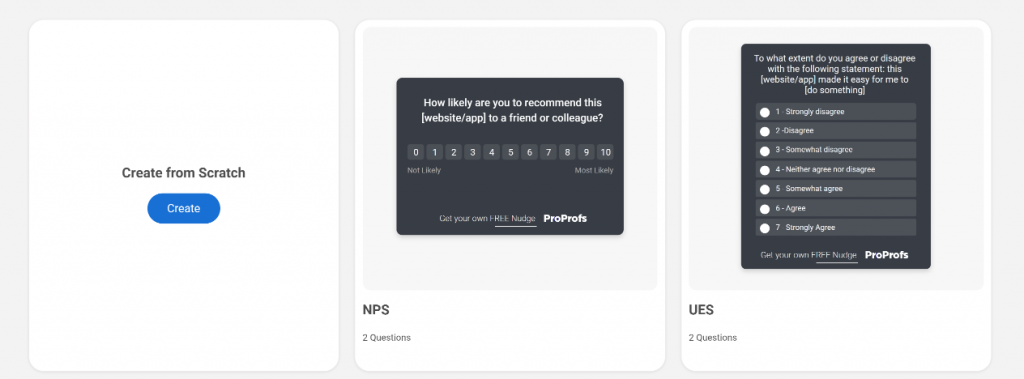
What is the Importance of Asking the Right CSAT Questions?
Asking the right questions in a customer satisfaction survey is of paramount importance for several reasons:
- Gather the Desired Feedback: Well-crafted customer satisfaction survey questions let you gather targeted customer insights. These questions help open a conversation with the customers to delve deeper into their experiences, perceptions, and concerns with your brand.
- Higher data reliability and quality: The type of questions you include in your survey directly impacts the data quality and accuracy. For example, to collect feedback on newly released product features, you must tailor the questions to ask about ease of use and usefulness.
With focused questions, you can understand users’ consensus about the features, interpret the results accurately, and draw accurate conclusions to make informed business decisions.
- Identifying key drivers of satisfaction: The right questions help you identify the key factors contributing to customer satisfaction. What are the best aspects of your product/service/brand? What are the expectations of your customers? What are the top three factors defining customer loyalty and satisfaction?
Once you have the answers to these questions, you can allocate the resources to improve specific areas along the customer journey and promote customer delight.
- Benchmarking and tracking CX: If you regularly run the customer satisfaction survey, you can collect the CX scores and create a benchmark. Then, use it to track the progress of your strategies and changes in customer sentiment.
If the scores improve over time, the changes are working. If you see a decline, you can take the necessary steps to keep the efforts on track. It will let you monitor trends and identify improvements in satisfaction levels.
5 Tips for Writing Great Customer Satisfaction Survey Questions
Creating customer satisfaction surveys is not that difficult, but you should approach the task with some key recommendations in mind to make the most of your efforts.
Let’s look at seven quick tips for designing amazing customer satisfaction surveys:
1. Keep Surveys Short and Crisp
Customer satisfaction surveys should aim to gather information and not interrogate. Stay mindful of your customer’s time by creating customer feedback surveys that are short yet meaningful.
For instance: How would you rate our service?
- Loved it
- Great
- Decent
- Disliked
- Hated it
Keep your questions simple and to the point. When phrasing a question, you need to make sure the recipients don’t have a lot to unpack so that they can give more honest and genuine feedback.
An easier way to do this is by using built-in survey templates from a survey feedback tool like Qualaroo. This will give you all the right questions to help you get started.
2. Avoid Double-Barreled Questions
A common mistake that survey creators make is that they ask double-barreled questions, which confuse the audience.
Start with pinpointing the objective of your customer feedback surveys and then build your customer satisfaction questionnaire around that objective. Always remember that one question should only fulfill one objective.
For instance: Poorly framed question
- Did you like our service, and would you consider coming back?
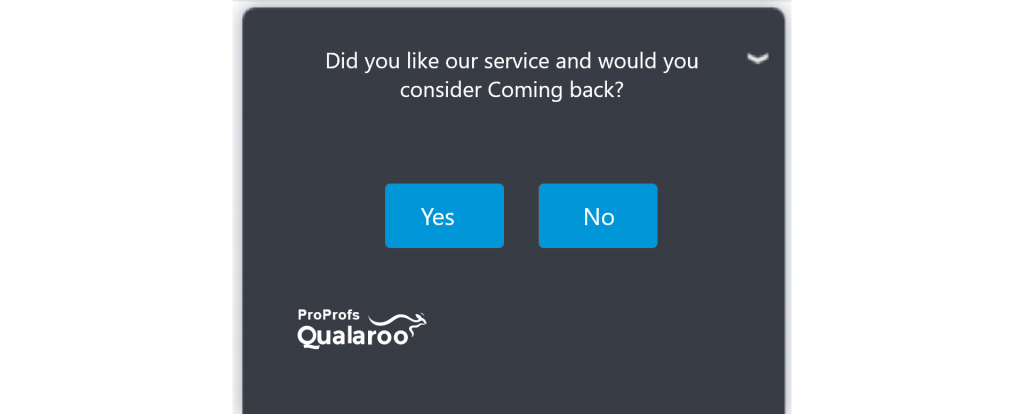
Properly framed question
- Did our service meet your expectations?
You can break your double-barreled questions into two separate questions. This will allow you to fulfill multiple objectives without confusing the audience.
3. Let Customers Speak Their Mind
Customers’ opinions matter. But you can’t get an honest opinion if you offer close-ended or restricted questions. A great way of getting insights into your products/services is by letting your customers share their thoughts and opinions through open-ended questions. You can also use these open ended questions during customer interviews for a more conversational approach
Your open-ended questions can be framed like this:
- “Tell us more about how….”
- “What more would you like to….”
- “How can we improve our….”
The good thing is that these questions will let you in on tons of insights from engaged customers who would love to share their feedback to see further improvements.
We recommend using one open-ended question per survey and always at the end so the audience can close with a personalized message.
You can also refer to our detailed article on survey errors you need to avoid to conduct successful surveys.
4. Keep Your Customer Satisfaction Survey Questions Neutral
One thing you should avoid at all costs when building your survey questions is adding an opinion.
By opinionating your customer satisfaction survey questions, you are influencing your audience and potentially leading them to answer your surveys in a way that doesn’t reflect how they truly think.
Opinions can sabotage your surveys by giving you false information from your customers.
For instance: Leading Question
- We think our customer support is awesome! What are your thoughts?
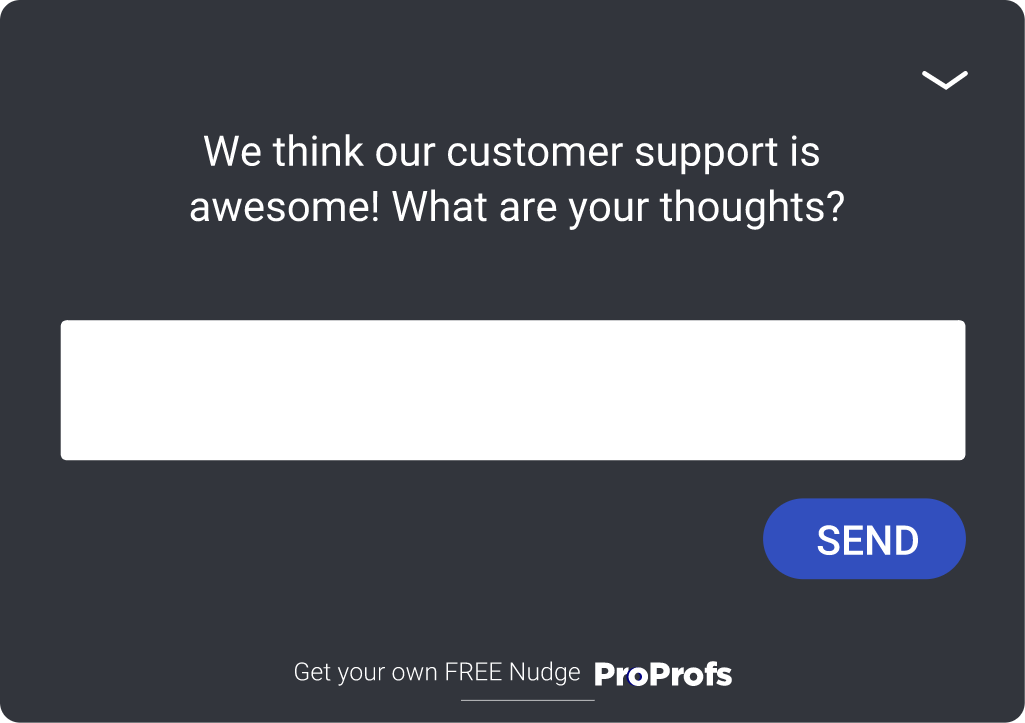
Neutral Question
- How would you rate our customer support?
If you are really looking to gather honest feedback on your customer support, your questions should not convey your personal thoughts.
Instead, let your customers tell you what they honestly think by building objective questions that have no hidden meanings.
Related Read- How to Write Good Customer Survey Questions
5. Get Help From a Question Library
Another effective survey resource is a question library.
Question libraries are extremely popular in the survey building community because they save you the time of writing the entire customer satisfaction questionnaire from scratch and ensure that your customer feedback survey questions are nearly perfect for every scenario.
Also, you can just simply import questions from a question library into your surveys and make the process even more seamless.
FREE. All Features. FOREVER!
Try our Forever FREE account with all premium features!
How to Choose the Right Customer Satisfaction Survey Questions
Seeing an endless list of questions to choose from can be confusing. Consider the following steps to select the right types of customer satisfaction survey questions for your next campaign:
1. Define Your Objectives
You may be tempted to ask many different questions about the customer experience with your brand and teams. But the survey needs to be short. So start by defining the goals of your survey.
What kind of insights do you want to gain? What aspects of customer satisfaction do you wish to measure? For example, you might focus on overall satisfaction, product quality, customer support, or specific touchpoints in the customer journey.
2. Choose the appropriate Question types
Different question types collect unique data sets. For example, single and multiple-choice questions are great for segregating the audience. In contrast, open-text questions collect more in-depth feedback from the respondents.

In the same way, a Likert scale question gathers feedback on a spectrum of 5 or 7 choices. So choose the formats that best suit your objectives and allow respondents to provide meaningful input.
3. Balance Quantitative and Qualitative Data
Quantitative data (closed-ended) provide measurable numbers in the form of ratings or rankings to gauge the customers’ experience. Qualitative data (open-ended) allows customers to speak their minds to record their opinions, concerns, and suggestions.

Adding more open-ended questions would make the survey unnecessarily long and increase the risk of abandonment. But if you include only closed-ended questions, you may miss out on collecting essential insights into customers’ experiences.
So strike a balance between qualitative and quantitative data types to get a comprehensive understanding of customer satisfaction. For example, you can add a qualitative follow-up question after a quantitative one to get in-depth feedback.
4. Customize the questions for Your Business
Whether using a customer satisfaction survey template or creating one from scratch, customize survey questions to suit your products, brand, and services. Personalize the language so they are easy to understand and ensure they reflect the unique aspects of your business. It will help improve the data reliability and enhance response rates.
5. Pretest and Refine Questions
It’s a great practice to pretest the survey before finalizing the customer satisfaction questions. It will help evaluate the questions’ clarity, relevance, and effectiveness. You can then refine them and make necessary changes to ensure they are easily understood and capable of capturing the intended feedback accurately.
Know your customers' expectations & satisfaction Deep dive into your customer experience & how you can make it better.
How to Launch a Customer Satisfaction Survey: 5 Steps
Here’s a look at how to deploy a CSAT survey easily and quickly:
Step 1: Choose the Right Tool
Selecting the appropriate tool is one of the most important steps in designing any survey campaign. It will help to set up a proper feedback loop and scale up your strategies if needed.
Consider different aspects like multi-channel deployment, budget, and ease of use when choosing the survey tool.
For example, Qualaroo lets you collect CSAT scores over the website, app, email, and other channels. Plus, in-depth reporting helps to interpret the results without manual effort. Research and compare different survey platforms to find the one that suits your needs.
Step 2: Pick the Desired Deployment Channel
Determine the channel where you want to deploy the survey. Add the survey to desired web pages to collect contextual feedback. If you wish to target the off-site audience, you can embed the survey in the mail and send it.
The deployment channel would also depend on the touchpoint you are trying to target. For example, if you are collecting feedback about a recent purchase, you can use an in-product customer satisfaction survey or send a survey mail.
Step 3 :Choose the Template or Design from Scratch
Most survey tools offer pre-made customer satisfaction survey templates. It provides a convenient starting point by offering pre-built question formats and designs tailored for customer satisfaction surveys. Or you can also create a customized survey from scratch. It would allow for complete customization and branding alignment.
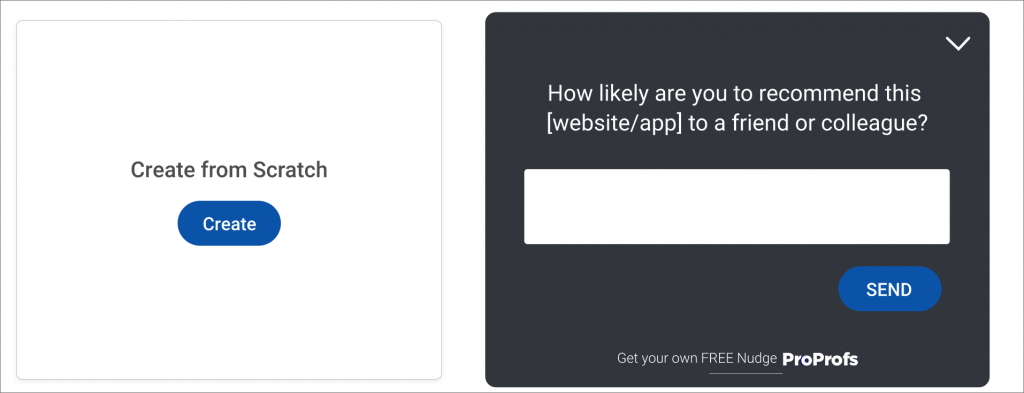
Step 4:Customize the Survey Questions & Theme
Tailor the customer satisfaction survey questions to your needs. Make sure the questions are clear and relevant to your campaign objectives. Include both closed-ended and open-ended questions to capture both quantitative and qualitative data.
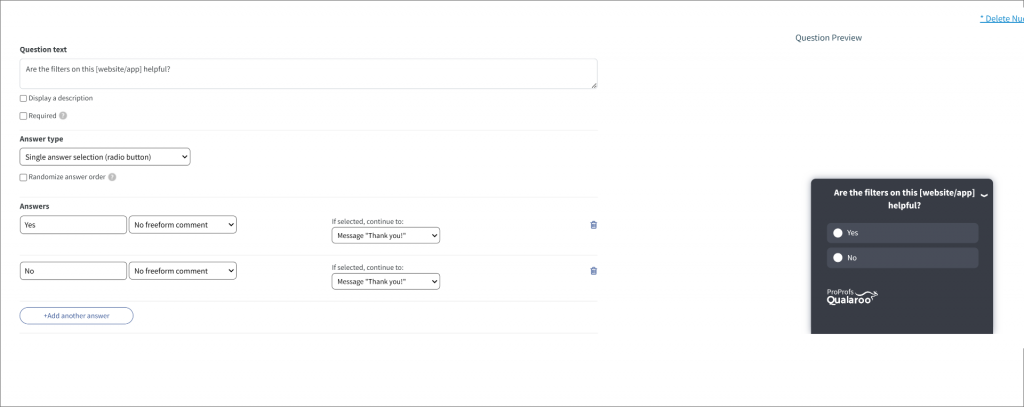
Also, you can also customize the survey theme and add your logo to align it with your brand and personalize it.
Step 5 :Launch the Survey and Monitor the Results
Once the survey is ready, test it to weed out any issues. Then, launch it through the chosen deployment channel.
Monitor the survey results to track response rates and CX scores. You can stop the survey once you reach the desired sample size and focus on closing the feedback loop.
Tools like Qualaroo also provide AI-based sentiment analysis engine to dig through the feedback data in real time and categorize the results.

Case Study: Marketade
Always Ask the Right Questions
Knowing your customer’s satisfaction level is instrumental to your business growth. Customer satisfaction surveys can help you create positive and lasting changes in your company.
Not to forget, a good online survey tool like Qualaroo will make this process even more seamless. It offers a range of built-in survey templates with over 12 different question types to help you create surveys instantly.
Also, with a wide range of advanced targeting options and multi-channel surveys, you can find your customers where they are and gather feedback seamlessly. With the best survey questions and a good online survey tool at your disposal, you can power up your customer satisfaction surveys and make them impactful.
 Tips
Tips
We’d love to hear your tips & suggestions on this article!
FREE. All Features. FOREVER!
Try our Forever FREE account with all premium features!



 We'd love your feedback!
We'd love your feedback! Thanks for your feedback!
Thanks for your feedback!

